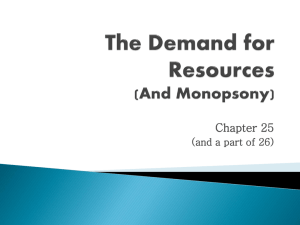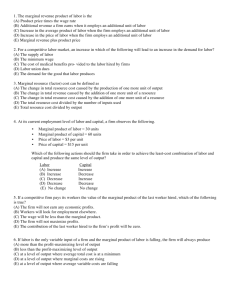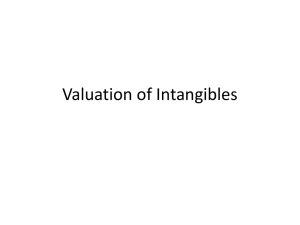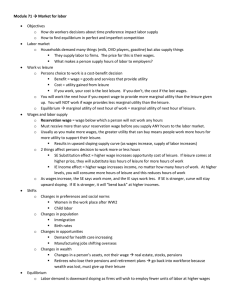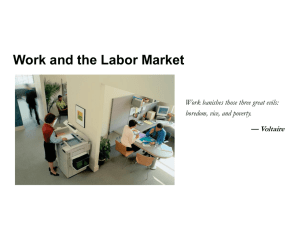Earnings and Discrimination
advertisement
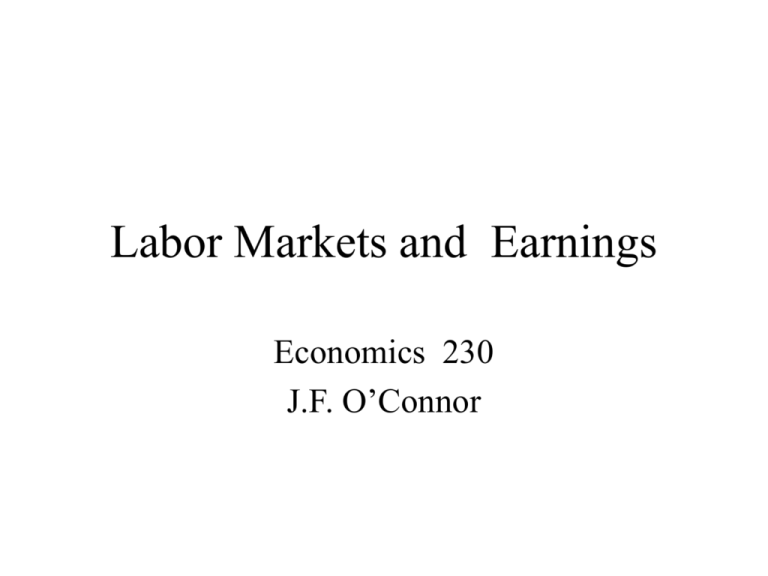
Labor Markets and Earnings Economics 230 J.F. O’Connor The Issues • Review the basic model of the labor market • Equilibrium wage for a given kind of labor is determined by intersection of supply and demand for that kind of labor • Why so much observed variation wage rates and in labor earnings? We need to look at what is behind demand and supply in the markets for different kinds of labor. The Firm’s Demand for Labor • Derived from the demand for the firm’s output. • The firm hires labor up to the amount where the marginal benefit of doing so equals the marginal cost. • For a perfectly competitive firm, the marginal benefit of hiring another unit of labor is the value of the marginal product. The Value of the Marginal Product • The marginal product of labor MP(L) is the change in output that arises when the amount of labor is changed by one unit. • The value of the marginal product of labor VMP(L) is the price of the product, P, times the marginal product of labor, MP(L). VMP(L) = P*MP(L) Labor Demand • For a price taker, the marginal cost of a unit of labor is the wage rate, w. • The MB=MC condition becomes in this case, VMP(L) = w The VMP(L) is the firm’s demand for labor. • Summing across firms’ gives the market demand for labor Revenues per Unit of Labor 9 $ / u n i t , 8 7 6 5 o f l a b o r VMP 4 3 2 1 0 0 50 100 150 200 250 300 Person hours 350 400 450 500 Labor Supply • The supply of labor arises from the individual’s choice between work and leisure. People derive utility (satisfaction) from leisure but they also derive utility from the goods that can be acquired with the earned income that arises from work. The opportunity cost of another hour of leisure is the wage rate. As the wage rate increases, we expect people to work more? EquilibriumintheLaborMarket 8 7 6 $per unit 5 4 3 2 1 0 0 20 40 60 80 100 Unit 120 140 160 180 200 Shifts in Demand and Supply • An increase in demand for labor caused by: – An increase in demand for the product – An increase in labor productivity • An increase in capital per worker • An increase in labor quality • A technological advance • An increase in supply caused by: – More people join this kind of labor – Change in labor-leisure preferences Why do Wages Differ • • • • • Human capital Ability, effort, chance Compensating differentials Labor Unions Discrimination Human Capital • Human capital is the stock of productive skills that a worker has as a result of education, training, and experience. • Workers with more human capital earn more than workers with less. College graduates earn 65% more than high school graduates. Qualified electrician earns more than an apprentice electrician. Why? • They are more productive. Higher VMP. Hence higher demand! Ability, Effort, and Chance • Major league vs. minor league players • People who work harder tend to earn more • Some people are lucky because they picked a job that resulted in higher than expected wage because of chance development. Others picked jobs that became redundant because of unforeseen developments. Compensating Differentials • Refer to differences in wages that reflect non-monetary characteristics of the jobs • “Good” jobs pay less than “bad” jobs • Jobs differ in terms of a wide variety of characteristics. For example: location, time of day, chance of injury, colleagues, security, prospects for advancement. Examples • Coal miners are better paid than other workers with comparable skills. Why? • Economics professors are paid less than economists in private business. Why? • Government employees are paid less than persons with comparable skills in the private sector. Why? Signaling and Superstars • Argument is that education is a way for people with superior ability and motivation to convey that information to potential employers. If employers screen on the basis of education, the scheme works. • Why watch #5 play when you could be watching #1 play? If the technology is there for people to do so, then the demand for #1’S services will be much higher. Common in entertainment and professional sports Labor Unions • Labor unions are concerned about both working conditions and wages. • If there are two industries employing the same kind of labor and one is unionized and the other is not, then if wages in the unionized industry are above equilibrium, this will depress wages in the second industry Discrimination • Offering different opportunities to similar persons who differ only by race, ethnic group, gender, age or other personal characteristics • How much discrimination is there at present? Not answered by looking at averages! Have to hold other factors constant. Where Do We Stand? • Historically, there certainly was discrimination against ethnic and racial groups and against females in many labor markets. • Presently, it is more difficult to find clear evidence of discrimination but there is a belief that it has not disappeared entirely.



